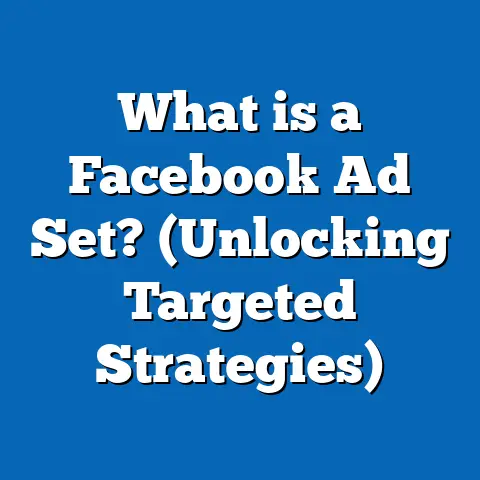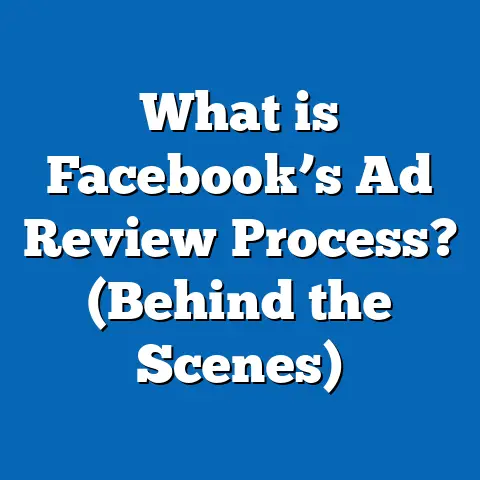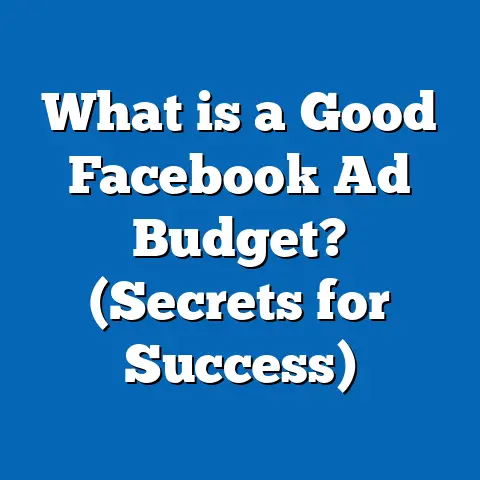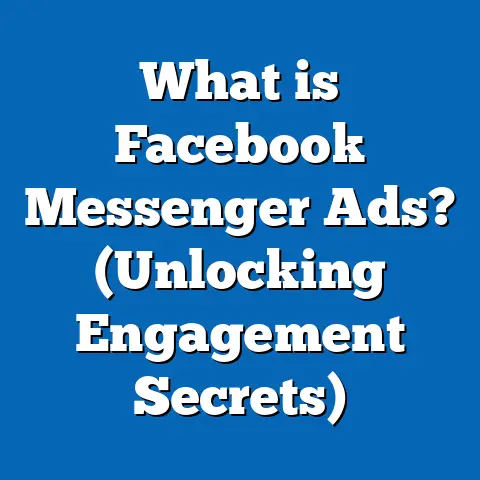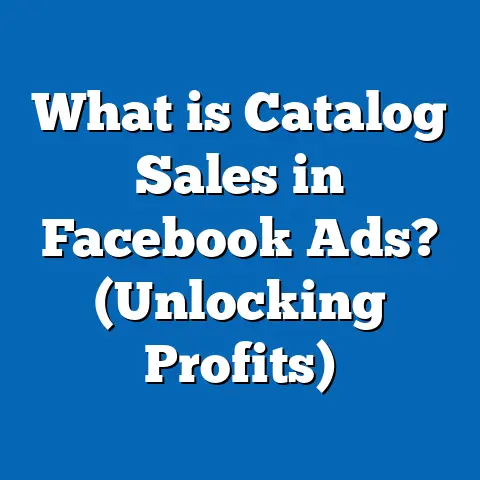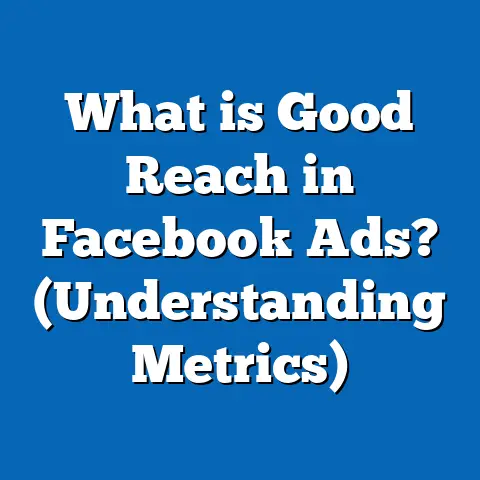What is a Deep Link in Facebook Ads? (Unlock Targeted Traffic!)
What is a Deep Link in Facebook Ads? (Unlock Targeted Traffic!)
Introduction: Setting the Scene
Picture this: You are running an ad campaign on Facebook for your mobile app or online store. You’ve spent considerable time crafting the perfect ad copy, selecting the ideal audience, and designing eye-catching creatives. Your ad gets clicks, but when users arrive at your app or website, they don’t find what they expected. Instead, they land on the homepage or a generic landing page. Confused and impatient, many leave without converting, frustrated by the extra steps.
This scenario is far too common. In today’s fast-moving digital world, users expect instant gratification. They want their journey from ad to desired content to be as smooth and direct as possible. This is where deep linking comes in—a powerful tool in Facebook Ads that can transform your traffic into loyal customers by delivering them exactly where they need to be.
Understanding deep links unlocks the potential of your advertising campaigns by enhancing user experience and drastically improving conversion rates. If you want to master Facebook advertising in 2025 and beyond, grasping deep linking is no longer optional; it’s essential.
Understanding Deep Links: The Basics
What is a Deep Link?
A deep link is a hyperlink that takes users directly to specific content within an app or a particular page on a website rather than just the homepage or starting point.
Let’s break this down with examples:
- Website deep link: A URL like
www.example.com/product/123sends users directly to a product page rather thanwww.example.com. - Mobile app deep link: When clicked, it opens the mobile app and brings the user to a particular screen or feature, such as a special offer or product detail.
Why Regular Links Aren’t Enough
Most traditional ads use generic URLs that lead users to homepages or broad landing pages. While this approach works for awareness campaigns, it falls short when you want to drive action.
Generic links cause friction:
- Users spend extra time searching for what they saw in the ad.
- Confusion leads to frustration and abandonment.
- Lower conversion rates because users don’t find relevant content quickly.
How Deep Links Change the Game
Deep links remove this friction by taking users directly to what interests them, creating:
- Higher relevance: Users reach the exact content promoted.
- Better experience: Less navigation means less drop-off.
- Increased conversions: The clear path to action boosts sales, installs, or sign-ups.
Types of Deep Links Explained
Understanding the different types of deep links is crucial for effective implementation.
1. Basic Deep Links
Basic deep links open a specific location inside an app if it is installed. If the app isn’t installed, the link typically fails or redirects users poorly.
- Use case: Campaigns targeting existing app users.
- Limitation: No fallback for non-users.
2. Deferred Deep Links
Deferred deep links solve the problem of new users who don’t have the app installed yet. When clicked, these links:
- Send users to the app store (Google Play or Apple App Store) to install the app.
- After installation and first launch, automatically open the targeted content within the app.
This type bridges acquisition and engagement seamlessly.
3. Contextual Deep Links
Contextual deep links carry additional information about where the user came from, such as campaign details or user preferences.
- They allow personalization inside the app upon opening.
- Marketers can track user journeys more accurately.
- They enable dynamic experiences like pre-filled forms or custom offers based on referral context.
Data-Backed Insights on Deep Linking in Advertising
Conversion Rate Improvements
Multiple studies highlight how deep linking increases conversion rates significantly:
- According to Branch Metrics’ 2023 Mobile Growth Report:
- Apps using deep links see 3x higher retention rates compared to apps that don’t.
- Deferred deep linking boosts conversion rates by up to 40%.
- Click-through rates (CTR) are often 20%–30% higher when ads use deep links versus generic URLs.
Retention and Engagement Benefits
User retention is a critical metric for app marketers:
- Apps with deep linking report 40% higher 7-day retention.
- Personalized experiences enabled by contextual deep links increase engagement duration by 25% on average.
ROI and Return on Ad Spend (ROAS)
Facebook’s own data suggests:
- Ads optimized with deep linking yield 25% higher ROAS on average.
- Lower customer acquisition cost (CAC) due to better-qualified traffic reaching precise destinations.
How Deep Links Work in Facebook Ads
User Journey with Deep Links
- Ad Display: User sees an ad on Facebook tailored to their interests.
- Click Action: User clicks on the ad containing a deep link URL.
- Conditional Redirection:
- If the app is installed → The app opens directly to the targeted page or feature.
- If not installed → Deferred deep link directs user to install page; post-installation opens targeted content.
- Engagement: User interacts with personalized experience, increasing likelihood of conversion.
Technical Overview
Deep linking requires coordination between:
- URL schemes: Unique identifiers that open apps from browsers.
- Universal Links (iOS): Secure method Apple supports for iOS apps allowing HTTP URLs to open apps.
- App Links (Android): Equivalent Android protocol for seamless redirection.
Facebook Ads support integration with these protocols through SDKs and third-party platforms like Branch or Firebase Dynamic Links.
Setting Up Deep Links in Facebook Ads: A Practical Guide
Step 1: Choose a Deep Link Provider
Popular platforms include:
- Branch: Advanced deferred and contextual links with detailed analytics.
- Firebase Dynamic Links: Google’s solution integrated with Firebase SDK.
- Adjust: Mobile measurement partner with deep linking features.
Step 2: Create Your Deep Links
Using your chosen platform:
- Define target screens within your app or specific web pages.
- Add parameters for campaign tracking (source, medium, campaign name).
Step 3: Integrate Facebook SDK in Your App
Facebook SDK enables event tracking and supports deferred deep linking.
- Install SDK following Facebook’s developer guidelines.
- Configure deferred deep link handling to ensure proper redirection after installation.
Step 4: Build Your Facebook Ad Campaign
- In Ads Manager, insert deep link URLs as your destination URLs.
- Choose appropriate objectives (App Installs, Conversions).
Step 5: Test Across Devices
Test deep links on:
- Devices with app installed.
- Devices without app installed (to verify deferred linking).
Testing ensures smooth user experience and proper tracking.
Step 6: Monitor and Optimize
Use Facebook Analytics along with your deep link provider’s dashboard to analyze:
- Click-through rates (CTR).
- Conversion rates.
- User retention metrics.
Adjust targeting and landing pages based on results.
Real-World Examples and Case Studies
Case Study 1: E-commerce Brand Boosts Sales by 35%
A fashion retailer ran Facebook campaigns promoting new arrivals but initially linked all ads to their homepage. The campaigns yielded a modest 3% conversion rate.
After switching to deep links directing users straight to product pages featured in ads:
- Conversion rate increased to 4.05%, a 35% rise.
- Bounce rates dropped by 20%.
- Average order value increased by 15%.
The retailer credited these improvements to reduced navigation friction and clearer paths to purchase.
Case Study 2: Mobile Game Increases Retention with Deferred Deep Linking
A mobile game studio used deferred deep links in Facebook Ads targeting new players. Users who installed the game via these ads landed on promoted levels or special offers instead of starting from scratch.
Results included:
- 7-day retention improved from 25% to 40%.
- In-app purchases increased by 30%.
- User lifetime value (LTV) rose substantially due to better onboarding experience.
This demonstrated how deferred and contextual deep links enhance new user engagement.
Case Study 3: SaaS Company Improves Trial Sign-ups
A SaaS company running lead generation ads sent traffic from Facebook directly into their onboarding screens using contextual deep links.
Outcomes:
- Trial sign-ups improved by 50%.
- Customer acquisition costs decreased by 18%.
The personalized onboarding flows created by passing campaign data through contextual deep links made sign-ups easier and faster.
Comparing Deep Linking in Facebook Ads with Other Advertising Platforms
| Feature | Facebook Ads | Google Ads | Snapchat Ads |
|---|---|---|---|
| Deep Link Support | Full support: basic, deferred & contextual | Supports basic & deferred via Firebase Dynamic Links | Supports basic only |
| Integration with App Stores | Seamless deferred linking via SDKs | Firebase-based deferred linking | Limited deferred capability |
| Tracking & Analytics | Native Facebook Pixel + SDK + third-party | Google Analytics + Firebase integration | Snapchat Pixel + limited third-party |
| Ease of Setup | Moderate complexity; requires SDK & URL setup | Moderate; Firebase recommended | Basic setup |
| Audience Targeting Precision | Superior audience targeting & retargeting | Strong keyword & intent-based targeting | Younger demographics focus |
Facebook’s blend of advanced targeting with robust deep linking support gives marketers an edge in precision user acquisition and retention campaigns.
Advanced Strategies for Maximizing Deep Linking Benefits
Strategy 1: Use Contextual Deep Linking for Hyper-Personalization
Go beyond simple redirection by including parameters that tailor user experiences:
- Pre-fill forms with user info.
- Show special discounts based on campaign source.
- Customize content language or region dynamically.
This boosts engagement by making users feel uniquely catered to.
Strategy 2: Combine Deep Linking with Dynamic Creative Optimization (DCO)
Pairing deep links with DCO lets you serve personalized creatives matched perfectly with landing pages inside your app—ensuring message consistency from ad impression to final action.
Strategy 3: Employ Sequential Retargeting Using Deep Links
Use initial ads with deferred deep links for acquisition, then retarget engaged users with ads linking deeper into premium features or upsells inside the app.
This layered approach nurtures users along the funnel efficiently.
Strategy 4: Optimize Based on Device Type and OS
Create device-specific deep links that leverage unique features of iOS or Android apps for better performance:
- Use Universal Links on iOS for seamless app opening.
- Use App Links on Android for reliable redirection without prompts.
Tailoring experiences by device improves usability and reduces drop-offs.
Common Challenges with Deep Linking in Facebook Ads & How to Solve Them
| Challenge | Cause | Solution |
|---|---|---|
| Broken or Misconfigured Links | Incorrect URL schemes or expired tokens | Use link validation tools; test every campaign before launch |
| Inconsistent Behavior Across Devices | Partial implementation of Universal/App Links | Fully implement platform-specific protocols; test thoroughly |
| Loss of Attribution Data Post Install | Deferred linking not set up properly | Use trusted providers like Branch that preserve referral info |
| Complex Tracking & Reporting | Multiple platforms and tools involved | Integrate Facebook Analytics with third-party dashboards for unified reporting |
| User Privacy Changes Affect Tracking | New privacy rules limit data sharing | Use aggregated data insights; focus on first-party data collection |
Technical Deep Dive: How Deferred Deep Linking Works Under the Hood
Deferred deep linking involves several moving parts coordinated between Facebook Ads platform, app stores, and your mobile app:
- User clicks ad → Facebook tracks click ID and passes it via URL parameters.
- Redirect to App Store → If app not installed, user lands on store page through a special redirect URL preserving click data.
- App installation & first launch → App SDK reads stored click data from install referrer APIs (Android) or Universal Link contexts (iOS).
- App opens targeted content → Based on click data, app navigates user directly to intended screen or feature.
- Events tracked back → Conversion events are reported back to Facebook Ads Manager for attribution.
This process requires precise synchronization between ad campaigns, SDK integration, and backend systems but delivers seamless user experiences when done correctly.
Best Practices for Creating Effective Deep Linked Facebook Ads
- Know Your Audience: Tailor your deep linked destinations based on audience segments identified in Facebook Ads Manager.
- Create Clear Call-To-Actions (CTAs): Use action words that align with destination pages (e.g., “Shop Now” leads directly to product page).
- Use UTM Parameters: For web-based deep links, add UTM tags to track traffic sources in Google Analytics alongside Facebook reports.
- Leverage Video & Carousel Ads: Showcase multiple products or features with corresponding deep links driving users directly where they want.
- Keep Landing Pages Fast & Mobile Optimized: Ensure linked content loads quickly across devices; slow load times kill conversions.
- Regularly Audit Your Links: Periodically test all active deep links to catch broken URLs before users do.
- Align Messaging Across Funnel: The ad creative’s promise should match exactly what users find after clicking through deep links—consistency builds trust.
Future Trends in Deep Linking and Facebook Advertising
Growth of AI-Powered Personalization
AI will increasingly power dynamic generation of contextual deep links based on real-time user behavior signals, creating ultra-personalized journeys from ad click through conversion.
Privacy-Centric Innovations
With privacy regulations tightening globally, expect more privacy-preserving attribution models integrated into deferred deep linking frameworks enabling marketers to measure impact without compromising user data.
Cross-Platform Linking Expands
Deep linking will evolve beyond mobile apps into connected devices ecosystems (smart TVs, wearables), letting brands create unified experiences across multiple touchpoints starting from social ads.
Summary: Key Takeaways & Next Steps
- Deep links are crucial tools for driving targeted traffic from Facebook Ads directly into relevant app screens or website pages, reducing friction and boosting conversions.
- There are three main types of deep links — basic, deferred, and contextual — each serving different marketing needs.
- Data shows clear advantages of using deep linking: higher CTRs, increased retention, improved ROAS, and better user engagement.
- Setting up deep linking requires technical steps including SDK integration and URL configuration but platforms like Branch and Firebase simplify this process.
- Testing across devices and continuous optimization ensure smooth user experiences and maximize campaign performance.
- Use advanced strategies like personalization via contextual deep links, sequential retargeting, and device-specific optimization for best results.
- Stay updated on evolving privacy policies and technology trends shaping future opportunities in Facebook advertising and deep linking.
Mastering deep linking can transform your Facebook advertising strategy — turning clicks into loyal customers by delivering personalized experiences instantly at scale. Start applying these insights today to unlock highly targeted traffic that converts better than ever before!

